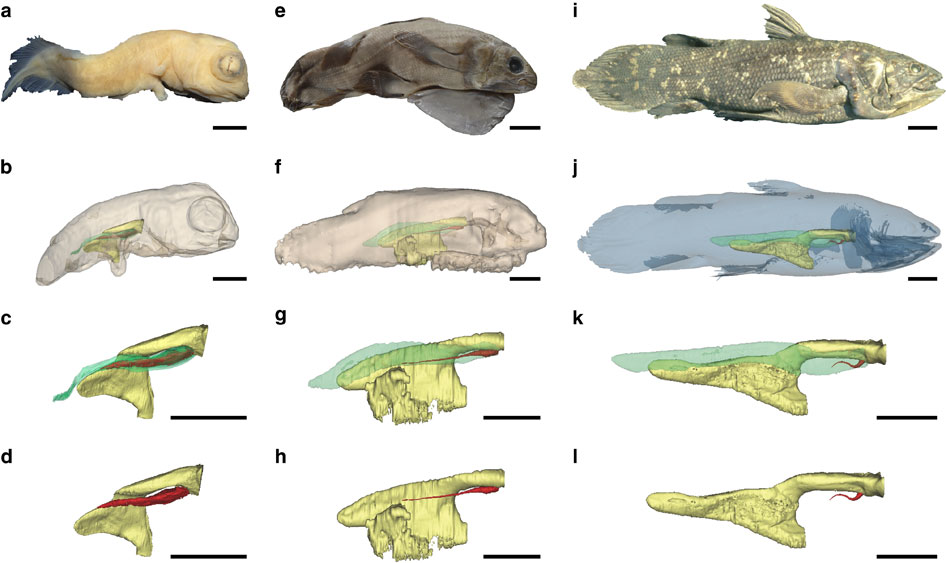The Weird and Wonderful Coelacanth – Once an Air Breather
An international team of researchers led by scientists at the Department of Zoology at the University of Rio de Janeiro (Brazil), have discovered that the bizarre “living fossil” Coelacanth has a vestigial lung in its abdomen. This organ, now obsolete, is an evolutionary left over from when the ancestors of the extant species lived in oxygen poor waters millions of years ago.
The fossil record of the Coelacanths part of the group of predatory Sarcopterygian fishes, dates back to the Devonian (about 410 million years ago), once widespread, living in a variety of freshwater and marine habitats these fish were believed to have died out at around the same time as the dinosaurs. However two extant species are known, both in the genus Latimeria (Latimeria chalumnae and L. menadoensis). Latimeria chalumnae is found in deep water between 200 and 400 metres deep off the coast of South Africa with a particular concentration around the Comoros Islands.
Coelacanth Specimen Caught in 1938
The first specimen known to science was caught in 1938. Latimeria chalumnae is coloured deep blue with white spots. The second species L. menadoensis, is predominantly brown in colour and it was scientifically described in 1999. This species seems to be confined to the deep waters off the Indonesian island of Sulawesi.
A Model of a Coelacanth
Picture credit: Everything Dinosaur
Safari Ltd have created a beautiful model of a Coelacanth: Safari Ltd. Wild Safari Prehistoric World.
Latimeria chalumnae
The team of international researchers which also included scientists from France and Japan studied a total of five Latimeria chalumnae specimens a various growth stages and following dissections as well as three-dimensional reconstructions they discovered that the vestigial lung is proportionally much larger in the Coelacanth embryo but the growth of this organ slows down as the fish matures. This suggests that the ancestors of modern Coelacanths evolved a lung to help supplement their breathing, perhaps as a result of living in low oxygen environments.
The deep water habitat of the two known species alive today are very stable and oxygen levels are relatively constant. As a result, the lung is not needed and it has become obsolete. A fatty organ has also been noted, this seems to act as a buoyancy aid. This research has been published in the journal “Nature Communications”.
Three Dimensional Reconstructions Showing the Development of the Vestigial Lung in Coelacanths

Three-dimensional images showing the development of the Coelacanth lung at different fish growth stages.
Picture credit: Brito et al (Nature Communications)
The picture above shows right lateral views of the specimens in the study showing the development of the lung. Pictures (a-d), early embryo with approximate length four cm. In pictures (e-h), the embryo is shown with a yolk sac around thirty centimetres in length. Pictures (i-l) an adult animal, approximate length 1.3 metres. Yellow = oesophagus and stomach, green the fatty organ and red equals the vestigial lung. The obsolete lung is proportionally much larger in the embryo than in the adult animal.
Studying Fossil Coelacanths
The presence of a strange, calcified sheath in the abdominal cavity of fossil Coelacanths, has been known for over 150 years. However, palaeontologists were not sure what these calcified plates represented. It had been thought that it was some sort of specialised internal organ, perhaps functioning like a swim-bladder. Only recently has this organ present in fossil Coelacanths been identified as a pulmonary organ (lung), positioned adjacent to the fish’s gut.
Although the anatomy of living Coelacanths has been studied extensively, little evidence concerning the presence of a lung in extant species had been found. However, it had been noted that adult animals had a large, fatty organ in the location where the lung was thought to be. How these structures found in modern Coelacanths related to the structures seen in fossils remained unclear. In this new research, the existence of a vestigial lung in L. chalumnae is confirmed.
In addition, the scientists propose homology (shared ancestry) between this lung and calcified lung found in fossils. The parallel development of a fatty organ for buoyancy control suggest a unique adaptation amongst the Coelacanth family for living in deep water environments.
Fish Evolution and the Coelacanth
Over the long course of this fishes evolution, the adaptation to living in stable, deep water, marine environments with its very low variations in oxygen content, may have resulted in the loss of the lung function. As the lung becomes proportionally smaller in adult specimens so there is an increase in the size of the fatty organ. This organ may help to stabilise this relatively large fish in the water column, an adaptation to living at depths of more than 200 metres.
The researchers speculate that adapting to a deep water environment may help to explain the survival of some Coelacanths. The stable, unchanging, deep water environments might have been much less affected by the global environmental crises marked by the End Cretaceous extinction event. Late Cretaceous Coelacanths inhabiting shallow marine environments or freshwater may not have been so lucky, hence their extinction.






